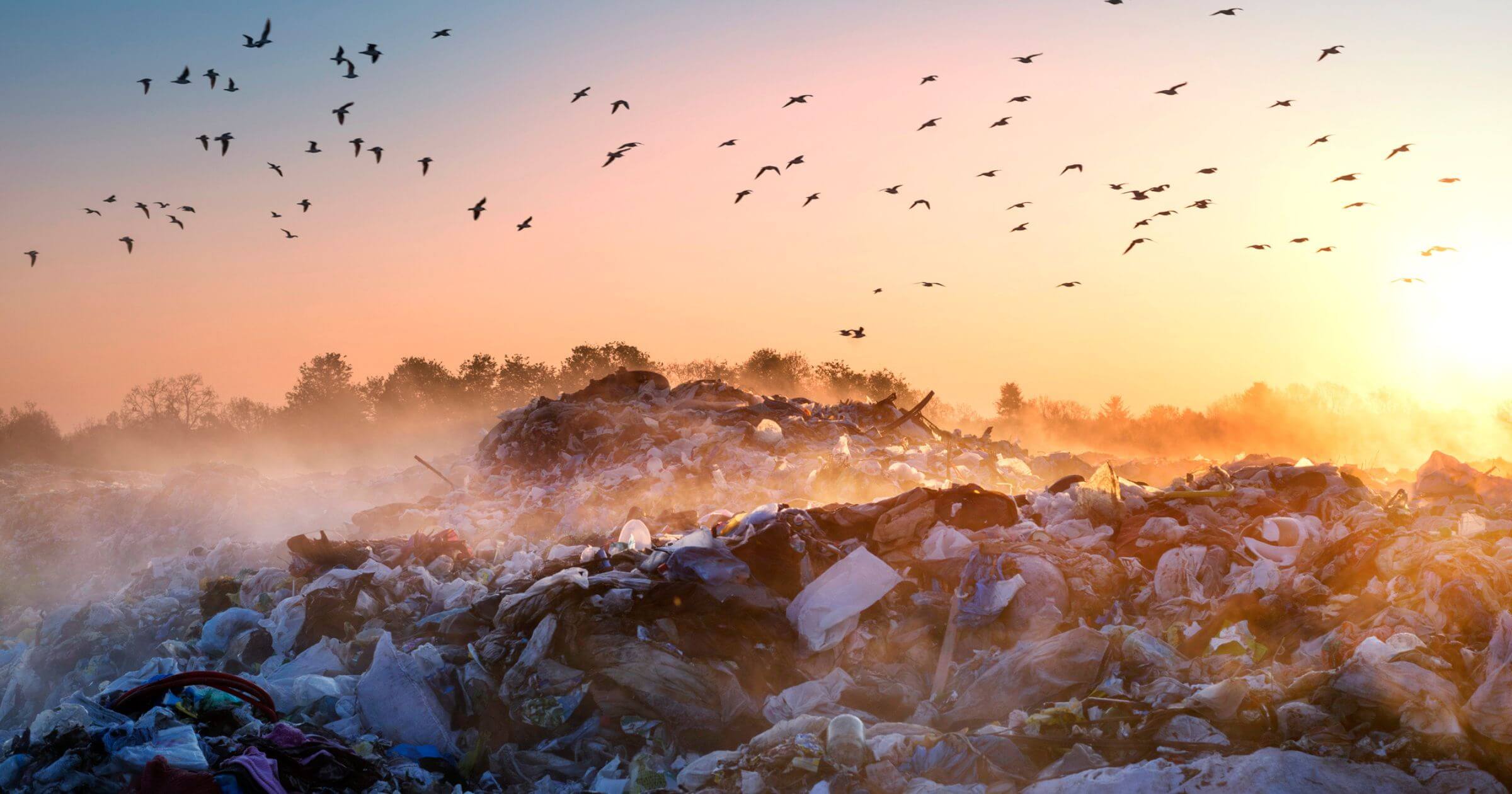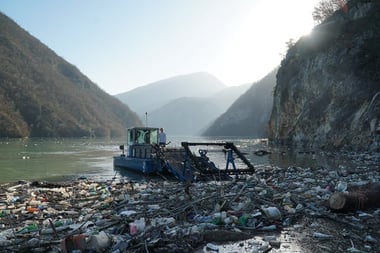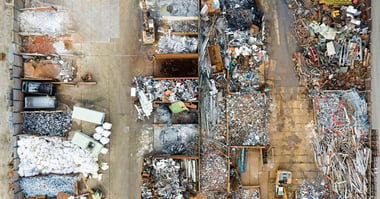At CleanHub, we want to make the world a better place — and we believe that one of the best ways to do this is by making ocean-bound plastic a thing of the past. Ideally, no plastic would ever end up in our oceans.
But that's easier said than done when our global economy relies on mass consumption and single-use products. We're all too quick to throw items in the trash.
To give you a better insight into how CleanHub works, we've outlined how we plan to move away from this destructive system and reduce ocean-bound plastic.
We call this our Theory of Change — and here's everything you need to know about it.
What's on this page?
01 | The problem with plastic pollution02 | The solution to plastic pollution: a circular economy
03 | Barriers to reaching a circular economy
04 | CleanHub's vision
05 | What are we doing to get there?
06 | Our impact
The problem with plastic pollution
Before we dive into our theory on how to solve plastic pollution, we need to understand the core issue at play.
Plastic has only been around for just over 100 years — and yet, it's found its way into every corner of the planet, harming ecosystems, increasing emissions, and leaching chemicals into the environment.
Commercial plastic production has skyrocketed since the 1970s, reaching 400 million tons per year. If we stay on this trajectory, it's estimated that 1,100 million tons of plastic waste will be produced by humans each year by 2050.
The most concerning fact? About 80% of this plastic waste is non-recyclable.
So what's the solution to this mess we've found ourselves in?
The solution to plastic pollution: a circular economy
As it stands, around half of all global plastic waste is single-use — meaning it's only used for a few minutes before being thrown in the trash.
This process of consuming raw materials and discarding products at the end of their use is part of what's called the linear economy. It's referred to as 'linear' because products have a beginning (being created), a middle (being used), and an end (being thrown away).
Instead of continuing with this linear system, we need to switch to a circular economy — a system where existing products and materials are reused and reintroduced into the buying cycle for as long as possible. This way, we reduce our reliance on new materials extracted from the planet and utilize waste, instead of dumping it.
Barriers to reaching a circular economy
If we were to design a circular economy from scratch, it would be a fairly straightforward process. But swapping from a linear economy to a circular one? That's going to take a lot of funding, expert knowledge from all angles, and plenty of time to adjust.
That's why we're currently faced with a handful of major barriers when it comes to moving to a more circular economy — we've listed the most pressing ones below.
Lack of waste management funding
One of the biggest challenges to reaching a circular economy is the lack of proper waste management in many nations.
Without an effective waste management system in place, individuals around the globe are left with the option of either discarding or burning waste. In fact, The World Bank estimates that at least 33% of today’s waste is mismanaged around the world through open dumping or burning.
It's often low-income countries that suffer the most from this, due to a lack of funding to build the proper infrastructure for waste management.
Not only does this mean developing countries are now drowning in waste, but it also delays their contribution to a circular economy.
Many European countries are now finding ways to add monetary value to waste by creating more recycling opportunities — but most developing countries are continuing to struggle with adopting this process, which is largely down to finances.
Poor working conditions
When it comes to the plastic pollution crisis, we're all in this together. This is a global issue that can only be solved if we work together and look after one another in the process.
This means we need to find ways to support waste workers in developing countries, who often work in poor conditions and have minimal social support.
The key reason behind these poor working conditions is the lack of funding — without money, there is no high-quality social provision.
Lack of standardization in waste management
There’s currently no standard operating model for waste management that social entrepreneurs can quickly set up and use.
This means entrepreneurs trying to establish waste management in their communities tend to waste resources trying to build a bespoke approach.
Recyclable materials aren't handled properly
As it stands, only 9% of plastic waste is recycled worldwide.
This figure will vary depending on the country you're looking at, but generally, low-income countries have lower recycling rates. That said, despite having the funds, the US is a key culprit when it comes to poor recycling rates, hovering around 5% in 2022.
But it doesn't just come down to money. Whether it's because individuals are unclear on recycling methods, reduced access to waste management, or lack of motivation, tons of recyclable materials are sent to landfill each year in countries around the world.
Reliance on non-recyclable materials
Despite increased knowledge of the plastic pollution crisis and growing support for sustainability, the world still relies heavily on non-recyclable plastic.
For manufacturers, this type of material is often more affordable and more easily accessible than alternatives, and it's typically very effective at protecting different products.
But a major caveat to non-recyclable materials is that they reinforce the linear economy, and are only used once before being discarded. Companies producing these materials also aren't held accountable for their disposal.
Restricted ways to deal with non-recyclable materials
Our ultimate goal would be to only have plastics in the economy that can be recycled and reused once a product reaches the end of its life. However, in the short term, we need to find greener ways to deal with non-recyclable waste.
As it stands, the only responsible way to reuse non-recyclable material is to burn it as fuel for cement manufacture, which reduces the industry's carbon footprint significantly. However, it does still release emissions.

CleanHub's vision
CleanHub was founded with one key goal in mind — to stop plastic from getting into our oceans.
To reach this goal, we've built an asset-light waste management system, which enables a circular economy and introduces a solution to plastic waste in vulnerable areas.
By 'asset-light', we mean a system that doesn't need expensive waste management hardware. Instead, we focus on bringing value through software and data.
Without effective waste management in these areas, recyclable plastic is the only waste that gets collected because it can be reused instead of extracting more resources, meaning it has monetary value. Non-recyclable plastic, however, has no monetary value because it can't be reused to make new products.
That's why the key focus in our plastic recovery efforts is on non-recyclable plastic waste.
Our long-term value proposition
Our long-term value proposition is the north star of our product roadmap. It focuses on two key components:
- Creating a product for socially motivated entrepreneurs, who aren't satisfied with tight profit margins when establishing critical waste management infrastructure in their community
- Having an asset-light waste management system that provides the best market prices for segregated waste
But that's not it — people are also at the heart of our plan for systemic change in a circular economy.
To make this goal achievable, we partner with brands around the globe. Not only does that mean we receive funding for plastic recovery, but it also means our model helps brands reduce their impact on the planet.
What are we doing to get there?
Since our inception in 2020, we've had the opportunity to work on some incredible projects, with inspirational people, and highly motivated brands. Together, we've collected over 8,000,000 kg of plastic waste from vulnerable areas — and counting.
Below, we've listed the key ways we've achieved this goal, and how we'll continue driving change around the world.
Working with brands
Together with hundreds of brands, we're addressing the issue of funding in waste management.
Since non-recyclable plastic has no monetary value, it's not collected and disposed of responsibly in low-income nations.
That's why we work with environmentally conscious brands — to fund the collection of non-recyclable ocean-bound plastic. These are consumer-focused brands, often based in developed economies, that want to take a proactive role in enabling the global circular economy.
You can choose from a range of packages. To find what best fits your sustainability goals, book a call to speak with us, or get started today and collect plastic waste for every product you sell.
Communicating change effectively
Our plastic recovery efforts are continuing to grow as the years go by — and that's all thanks to the wonderful brands we work with.
But it's important that we communicate this work effectively, and help brands educate their audience on the topic. That's why our communications and marketing team created the right content for brands to share with their audience.
Customers need to rest assured that their €1 really did enable 1 kg of plastic to be removed from the environment.
That’s why we also built — and are always continuing to find ways to improve — our track and trace app., which logs a detailed account of how much plastic has been collected, where from, and how much it weighs.
Supporting local communities
Local communities are the beating heart of our projects. We focus our plastic recovery efforts on areas that currently don't have an effective waste management system in place, meaning we have a huge impact on the local environment, wildlife, and people.
We approach each project with people in mind, making sure to carry out surveys that help us understand the locals' hopes, concerns, and queries.
Our selected collection hubs also provide locals with access to dignified work with proper health and safety standards in place, as well as health insurance.
Our impact
At CleanHub, we want a world free of plastic pollution — and we’re making this happen by collecting all kinds of waste from coastal communities, preventing it from being openly burnt, dumped, and reaching waterways.
So, how much waste have we collected so far? Let’s break it down.
As of March 2024, we’ve collected 9,529,203 kilograms (kg) of waste — all financed by our amazing brand partners. That’s the same weight as 317 humpback whales!
This is mainly made up of plastics but also contains paper, cardboard, and wet waste. Our collection hubs estimate that roughly 30% of the waste we collect and sort is recyclable plastic, which is then sold into the recycling process.
To make sure our projects have additionality — meaning they wouldn’t have happened without our financial support — we only incentivize and pay for non-recyclable waste. This is measured as ‘net-dry’ plastic waste where the moisture contents are deducted from the final weight.
On top of this, one of our key goals is to bring more transparency to the waste industry, which is why we also partner with waste managers beyond plastic credits, inviting them to use our technology to track collections and manage their operations.
Through this partnership, an additional 343,875 kg (correct at May 2024) of waste has been tracked using CleanHub’s technology, including mixed municipal solid waste or pre-sorted waste.
Summary
Plastic pollution is one of the few issues that impacts us all — it can be found in every corner of the planet, even at the bottom of the Mariana Trench. Researchers have also found microplastics in humans, and inside cloud formations.
Our concept is a simple one: we enable brands to stop plastic from entering the ocean — but it goes much further than that. We help brands reduce their plastic footprint, provide educational content, work with local communities to provide safe working environments, and help consumers find eco-minded brands.
Struggling to make sustainability measurable? Let's chat.

.webp)
-3.png)
.png?width=380&name=CleanHub%20Bcorp%20(1).png)
.webp?width=380&name=CleanHub-collectors-%20(1).webp)
.webp?width=380&name=warehouse%20(1).webp)
.webp?width=380&name=CleanHub-waste-sorters-%20(1).webp)

.webp?width=380&name=ESG-meeting%20(1).webp)
.webp?width=380&name=Water-bottles%20(1).webp)

.webp?width=380&name=Plastic-bales%20(1).webp)

